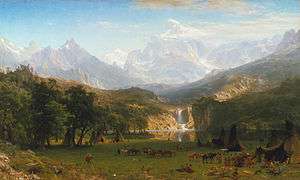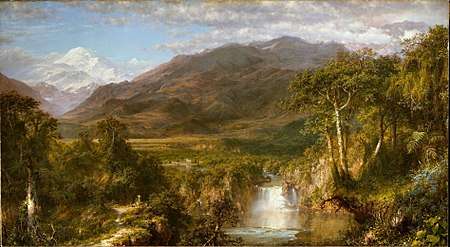The Rocky Mountains, Lander's Peak
The Rocky Mountains, Lander's Peak is an 1863 landscape oil painting by the German-American painter Albert Bierstadt. It is based on sketches made during Bierstadt's travels with Frederick W. Lander's Honey Road Survey Party in 1859. The painting shows Lander's Peak in the Wind River Range of the Rocky Mountains, with an encampment of Native Americans in the foreground. It has been compared to, and exhibited with, The Heart of the Andes by Frederic Edwin Church. Lander's Peak immediately became a critical and popular success and sold in 1865 for $25,000.
| The Rocky Mountains, Lander's Peak | |
|---|---|
 | |
| Artist | Albert Bierstadt |
| Year | 1863 |
| Medium | Oil on canvas |
| Dimensions | 186.7 cm × 306.7 cm (73.5 in × 120.75 in) |
| Location | Metropolitan Museum of Art, New York City |
Background
Hudson River School landscape painter Albert Bierstadt (1830–1902) was born in Germany, and, though his family moved to New Bedford, Massachusetts, when he was two, he spent many of his formative years in Europe.[1] He made his debut in an 1858 exhibition, but his breakthrough came in the aftermath of a journey he made the following year. In the spring of 1859, Bierstadt joined the Honey Road Survey Party led by then-colonel Frederick W. Lander.[2] He traveled as far as the Wind River Range in the Rocky Mountains, and made studies for numerous paintings along the way.[3] Bierstadt was greatly impressed by the landscape he encountered, and described the Rocky Mountains as "the best material for the artist in the world."[4] He had a habit of doing extensive preparation for his work, on occasion making as many as fifty sketches for a single painting.[5] In 1860, he exhibited Base of the Rocky Mountains, Laramie Peak at the National Academy of Design.[1] His greatest success, however, came with The Rocky Mountains, Lander's Peak, which he exhibited in 1863 at the Tenth Street Studio Building, where he also had a studio.[6]
Composition and theme
The painting shows Lander's Peak, a mountain with a summit of 10,456 feet (3,187 m) in the Wind River Range in modern-day Wyoming. The peak was named after Frederick W. Lander on Bierstadt's initiative, after Lander's death in the Civil War.[7] In one description of the painting, "Sharply pointed granite peaks and fantastically illuminated clouds float above a tranquil, wooded genre scene."[8] The foreground is dominated by the campsite of a tribe of Native Americans. The landscape in the painting is not the actual landscape as it appears at Lander's Peak, but rather an ideal landscape based on nature, altered by Bierstadt for dramatic effect.[4]
Bierstadt's painting hit a nerve with contemporary Americans, by portraying the grandeur and pristine beauty of the nation's western wilderness. It was a reference to the idea of Manifest Destiny, where the Rocky Mountains represented both natural beauty, and an obstacle to westward expansion.[9] In the words of historian Anne F. Hyde: "Bierstadt painted the West as Americans hoped it would be, which made his paintings vastly popular and reinforced the perception of the West as either Europe or sublime Eden."[8] At the same time, the Native Americans in the foreground gave the scene authenticity, and presented it as a timeless place, untouched by European hands.[10]
Depiction of Shoshone Peoples
At the forefront of the painting, Bierstadt paints a band of Shoshone Native peoples.[11] According to a review in Harper's Weekly from March 26, 1864, Lander's Peak, "is purely an American scene, and from the faithful and elaborate delineation of the Indian village, a form of life now rapidly disappearing from the earth, may be called a historic landscape."[12] Bierstadt illustrated Shoshone people along with the majestic peaks as a marker of the "sublime" which authors like James Fenimore Cooper, John C. Frémont, and Washington Irving wrote about.[1] Bierstadt does not include who these people are in his painting title. Unlike Catlin, Bierstadt focused not on the individuality of members of the Shoshone people, rather, his focus was on their relationship with landscape. As Bierstadt scholar Matthew Biagell suggests, as "He placed them, as he placed European peasants in earlier works, in the middle distance so that we witness their presence in a landscape setting rather than focus on their movements."[13]
In 1859, Eastern Shoshone peoples lived in the region now called Western Wyoming.[14] Bierstadt commented on the Shoshone people he saw in a letter from July 10, 1859 which The Crayon, an art magazine, published in September 1859.[15] "The manners and customs of the Indians are still as they were hundreds of years ago, and now is the time to paint them, for they are rapidly passing away, and soon will be known only in history. I think that the artist ought to tell his portion of their history as well as the writer; a combination of both will assuredly render it more complete"[15] Bierstadt adds, "We have a great many Indian subjects. We were quite fortunate in getting them, the natives not being very willing to have the brass tube pointed at them. Of course they were astonished when we showed them the pictures they did not sit for; and the best we have taken have been obtained without the knowledge of the parties, which is, in fact the best way to take any portrait"[15] The Shoshone people are depicted on a similar level as the nature of the image, and Biertstadt is attempting to capture an image of them and the Rockies, something which he believes must preserved as a part of history.
Reception

Lander's Peak was an immediate success; twelve hundred people were invited for the exhibition, and almost a thousand showed up.[6] Bierstadt was a shrewd self-promoter as well as a gifted artist, and this was the first of his paintings to be widely promoted with a single-picture exhibition, accompanied by a pamphlet, engravings and a tour.[16] The painting, with its ten-foot width, was intended both for exhibition halls and the homes of America's emergent millionaire class.[17] In 1865 it was purchased by British railway entrepreneur James McHenry for $25,000,[9] the most paid for an American painting to that point.[18] Bierstadt later bought it back, and gave or sold it to his brother Edward, before it was eventually acquired for the Metropolitan Museum of Art in New York in 1907.[7]
Comparisons were made between Lander's Peak and The Heart of the Andes, a contemporary painting by one of Bierstadt's main rivals in the landscape genre, Frederic Edwin Church.[1] The two works represented the two great mountain ranges spanning North and South America. At the New York Metropolitan Fair in 1864, held by the United States Sanitary Commission to raise money for the Union war effort, the two paintings were exhibited opposite each other.[19] Lander's Peak and The Heart of the Andes are still exhibited on opposite walls at their current location at the Metropolitan.[20]
Most reviews of the painting were positive; one review called it "beyond question one of the finest landscapes ever painted in this country", adding, "Its artistic merits are in some respects unrivalled: and added to these it has the advantage of being a representative painting of a portion of the most sublime and beautiful scenery on the American Continent."[21] The painting won a prize at the Exposition Universelle in Paris in 1867.[9] At the same time, there were also critical voices; in particular, some American Pre-Raphaelites found his brushwork wanting. One such critic complained that it would have been better "if the marks of the brush had, by dexterous handling, been made to stand for scrap and fissure, crag and cranny, but as it is, we have only too little geology and too much bristle."[22]
Notes
- Anderson, Nancy. "Bierstadt, Albert". Grove Art Online. Oxford Art Online. Retrieved April 17, 2011.
- Hendricks (1964), pp. 333–9.
- Hendricks (1964), p. 338.
- Hine & Faragher (2007), p. 196.
- Mayer & Myers (1999), p. 61.
- Houston & Houston (1999), p. 69.
- "The Rocky Mountains, Lander's Peak, 1863". metmuseum.org.
- Hyde (1993), p. 368.
- Facos (2011), p. 138.
- Miller (2001), pp. 46–7.
- "For Bierstadt's Eyes Alone, essay by Mary Terence McKay". tfaoi.org. Retrieved December 10, 2017.
- K., Anderson, Nancy (1990). Albert Bierstadt : art & enterprise. Ferber, Linda S., Wright, Helena, 1946–, Brooklyn Museum., National Gallery of Art (U.S.), Frank and Virginia Williams Collection of Lincolniana (Mississippi State University. Libraries) (First ed.). New York. ISBN 1555950590. OCLC 21875508.
- "Albert Bierstadt, essay by Matthew Biagell". www.tfaoi.org. Retrieved December 10, 2017.
- "Wyoming Indian Tribes and Languages". www.native-languages.org. Retrieved December 11, 2017.
- B.; N., B. E. (1859). "Sketchings". The Crayon. 6 (9): 280–289. doi:10.2307/25527949. JSTOR 25527949.
- Wolf (1992), pp. 433–4.
- Wolf (1992), p. 434.
- Wallach, Alan (2018). "Aestheticizing Tendencies in Hudson River School Landscape Painting at the Beginning of the Gilded Age". In Laster, Margaret R.; Bruner, Chelsea (eds.). New York: Art and Cultural Capital of the Gilded Age. Routledge. p. [ebook]. ISBN 9781351027564.
- Miller (2001), p. 46.
- Houston & Houston (1999), p. 70.
- Houston & Houston (1999), pp. 69–70.
- Mayer & Myers (1999), p. 62.
References
- Facos, Michelle (2011). An Introduction to Nineteenth-Century Art. Taylor & Francis. ISBN 978-1-136-84071-5. Retrieved April 29, 2011.
- Hendricks, Gordon (September 1964). "The First Three Western Journeys of Albert Bierstadt". The Art Bulletin. College Art Association. 46 (3): 333–365. doi:10.1080/00043079.1964.10788767. JSTOR 3048185.(subscription required)
- Hine, Robert V.; Faragher, John Mack (2007). Frontiers: A Short History of the American West. New Haven, Conn: Yale University Press. ISBN 978-0-300-11710-3. Retrieved April 29, 2011.
- Houston, Alan Freser; Jourdan Moore Houston (Summer 1999). "The 1859 Lander Expedition Revisited: 'Worthy Relics' Tell New Tales of a Wind River Wagon Road". Montana: The Magazine of Western History. Vol. 49 no. 2. Montana Historical Society. pp. 50–71. JSTOR 4520143.(subscription required)
- Hyde, Anne F. (August 1993). "Cultural Filters: The Significance of Perception in the History of the American West". The Western Historical Quarterly. Western Historical Quarterly, Utah State University on behalf of The Western History Association. 24 (3): 351–374. doi:10.2307/970755. JSTOR 970755.(subscription required)
- Mayer, Lance; Gay Myers (Spring 1999). "Bierstadt and Other 19th-Century American Painters in Context". Journal of the American Institute for Conservation. The American Institute for Conservation of Historic & Artistic Works. 38 (1): 55–67. doi:10.1179/019713699806113583. JSTOR 3179838.(subscription required)
- Miller, Angela (2001). "Albert Bierstadt, Landscape Aesthetics, and the Meanings of the West in the Civil War Era". Art Institute of Chicago Museum Studies. The Art Institute of Chicago. 27 (1): 40–59, 101–02. doi:10.2307/4102838. JSTOR 4102838.(subscription required)
- Wolf, Bryan J. (September 1992). "Review: How the West Was Hung, Or, When I Hear the Word "Culture" I Take Out My Checkbook (review of The West as America: Reinterpreting Images of the Frontier, 1820–1920 and Albert Bierstadt: Art & Enterprise)". American Quarterly. The Johns Hopkins University Press. 44 (3): 418–438. doi:10.2307/2712983. JSTOR 2712983.(subscription required)
External links
- American Paradise: The World of the Hudson River School, an exhibition catalog from The Metropolitan Museum of Art (fully available online as PDF), which contains material on this painting (see index)
- The United States of America, a catalog from The Metropolitan Museum of Art Libraries (fully available online as PDF), which contains material on this painting (p. 74–76)